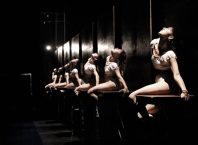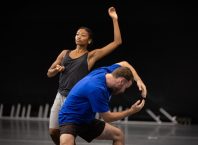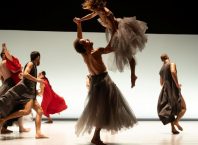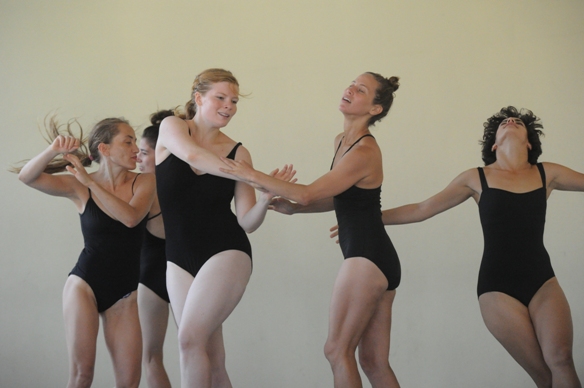
Girls. Beautiful, strong, delicate, intricate, visceral and alluring, choreographer Roy Assaf’s Girls is a work for five women dancers that moves from Skeeter Davisto Oum Kalthum, with intense action and an enigmatic smile. Girls will premiere on the opening night of Curtain Up 2013, developed under the artistic direction of Ronit Ziv, it will be performed by Ariel Friedman, Olivia Court Mesa, Yulia Kraus, Nitzan Moshe and Inbar Nemirovsky. Having seen and admired Roy Assaf’s work over the years, from his debut in Gvanim BeMahol 2005 with We Came for the Wings Stayed Because We Could Not Fly, to Six Years Later (Curtain Up 2011), and last year’s The Hill (Curtain Up 2012), I visited Roy and the dancers in the rehearsal studio for a closer look at Girls in progress and a conversation with the choreographer .
“I’m not trying to say something with Girls. I am not trying say something: attention, I have an important statement to make – NO. I didn’t do that with Six Years Later, or with The Hill, and what I know is that ultimately, people imagine. People see the dance and their imagination begins to work, they imagine all sorts of things…I don’t create works about something in order to take a position on it,” said Roy when I asked him about the origin of this new dance. He explained that for him, each dance he works on ignites the impetus for the next piece, and in that sense, he views his three latest works as part of a continuum.
Drawing an analogy to music, Roy said, “It is like listening to listening to Bach or Jean Sibelius – you feel. You listen to the music, you are not given a story or text or explanation. Later on, you can get into it and read but … some music, when you hear it, something happens in your body that you can’t ignore. Something happens to you, whether it’s excitement, fear, sadness, sometimes you can’t even describe it. You becomes suddenly very focused … that is the kind of dance I create.”
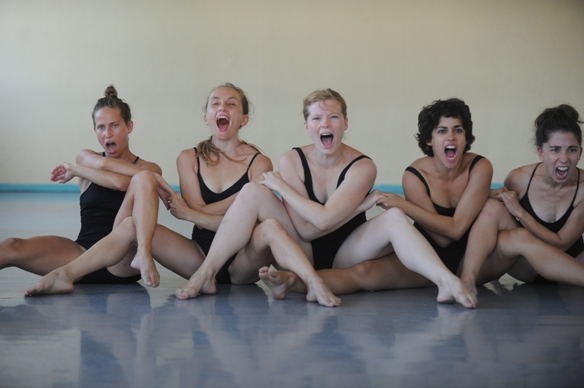
“My starting point? I always have to start from something, you might call it an excuse. It can be intellectual or technical – space, time, things happening between people, but it soon moves into this thing I described… feeling what the dance is about in terms of the tensions within it: the tension of the movement, the tension of the music, the time, the thing that is happening.”
Once the process is underway, Roy works on tightening the connections within the work, then observes the choreography “and then the thoughts arise.” Roy shared his process, re-enacting his response to seeing and shaping the dance as it develops: “Oh, if it’s like that, then you are not supposed to laugh now, you are supposed to laugh later, because then we will understand why you are laughing. It won’t be a laugh of embarrassment and confusion, it will be the kind of laughter in which you want to make us all laugh with you… you are all imprisoned somewhere… this comes after we have made the connections, the thoughts start to float up, and the tensions between the elements and that is when I begin to imagine, just like the audience, and then I can begin to put it into words.”
“The process doesn’t originate there, in a statement, and because it doesn’t begin there, it is always somewhat obscure, something that I can’t completely define it’s this, and this and this. You see five women who dance a dance, but what are they saying about femininity? If I had begun with that question then I would know what they are saying about femininity.”
Seeing Girls in rehearsal, I felt that the dance does not try to define or limit femininity to one thing, many things happen – physical and emotional, that take your thoughts and feelings to different places. It’s a work that enfolds surprises along the way; watching a scene one looks forward to its development, imagining where it might lead, then see it lead somewhere else, somewhere unexpected.
“Two roads diverged,*” Roy smiled on hearing my description, and added, “I think that is one of the strengths of dance. In theatre you have plot. You may be surprised, but you know where it’s going and what will happen. Here you don’t know what will happen. That is the strength of dance. I think you have to use that, the fact that you don’t know what will happen, the choreographer doesn’t know – he discovers, and lets himself discover it from intuition, from the encounter with something for the first time and not from thinking about something and determining it in a rational manner.”
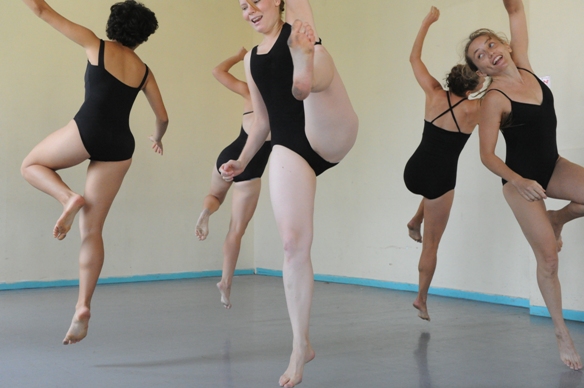
“On the contrary – in dance you are free from plot, free from a story that is known in advance. We can do what we want and I feel that we have to go there. One of my greatest struggles (in creating) is with the fear: what am I doing? Do whatever you want. Begin by doing whatever you want. Then later, begin to decode what you have created, limit it, critique it, cope with it, characterize it … say to yourself: this thing you made, it doesn’t work well, take it out. This thing you made, is full of potential, but you need to filter all these other parts and leave this part which is the essence of it all…I feel that I am telling you how I work (rather than talking about the work), but that is the essence, that is what I have to say about the work. Maybe in creating another dance I’ll work differently. Maybe one day I’ll make a dance about the Syrian-African rift.”
Girls by Roy Assaf
Artistic direction: Ronit Ziv; dancers: Ariel Friedman, Olivia Court Mesa, Yulia Kraus, Nitzan Moshe and Inbar Nemirovsky.
Performances:
Suzanne Dellal Centre, 5 Yehieli St, Tel Aviv – November 14th at 21:00, November 23rd at 21:00. Tickets are 60 NIS and may be ordered online or call 03-5105656.
Jerusalem Theatre, 20 David Marcus St, Jerusalem – November 25th at 20:30. Tickets are 60 NIS, to order call 02-5605755.
*Robert Frost “The Road Not Taken“

